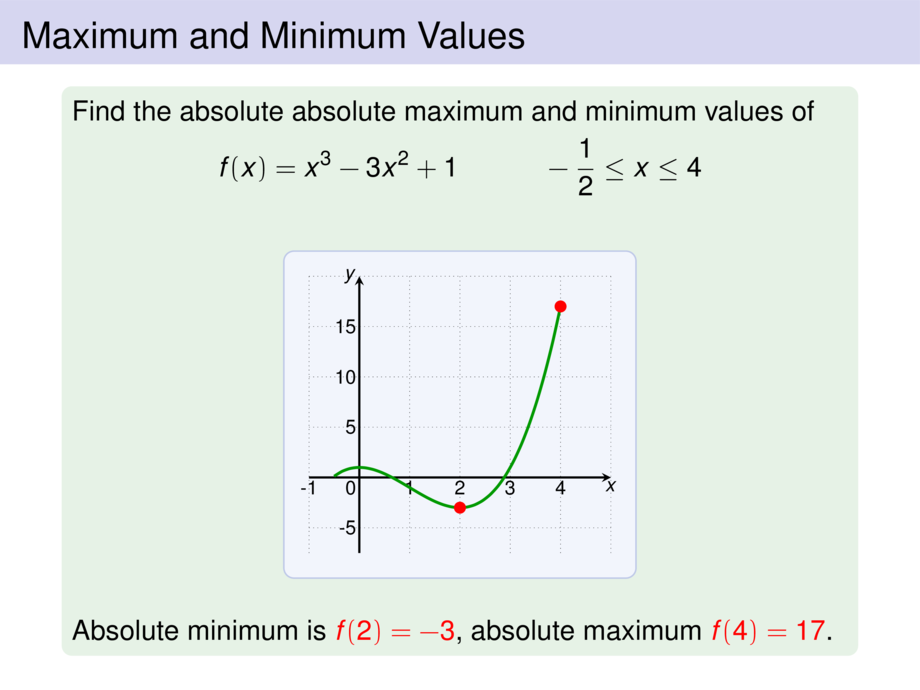



































































































159/209
\begin{frame}
\frametitle{Maximum and Minimum Values}
\begin{exampleblock}{}
Find the absolute absolute maximum and minimum values of
\begin{talign}
f(x) = x^3 - 3x^2 + 1 \quad\quad\quad -\frac{1}{2} \le x \le 4
\end{talign}%
\only<-19>{%
\pause
Since $f$ is cont. on $[-\frac{1}{2},4]$ we can use Closed Interval Method.
\begin{talign}
f'(x) = \mpause[1]{3x^2 - 6x}\mpause[2]{ = 3x(x - 2)}
\end{talign}
\pause\pause\pause
We have $f'(x) = 0$ if \pause \quad \alert{$x = 0$} \quad or \quad \alert{$x = 2$}. \quad\pause
\alert{Both in $[-\frac{1}{2},4]$!}\\\pause
No other critical values since $f'(x)$ exists for all $x$.
\pause\medskip
The values of $f$ at the critical numbers are:
\begin{talign}
f(0) = \mpause[1]{1} &&
\mpause[2]{f(2) =}\mpause[2]{ -3}
\end{talign}
\pause\pause\pause
The values of $f$ at the end points of the interval are:
\begin{talign}
f(-\frac{1}{2}) = \mpause[1]{-\frac{1}{8} - 3\frac{1}{4} + 1}
% \mpause[2]{= -\frac{7}{8} + 1}
\mpause[2]{= \frac{1}{8}} &&&&
\mpause[3]{f(4) =} \mpause[4]{4\cdot 16 - 3\cdot 16 + 1} \mpause[5]{= 17}
\end{talign}
\pause\pause\pause\pause\pause\pause
}
\only<20>{
\begin{center}
\scalebox{.7}{
\begin{tikzpicture}[default,baseline=1cm]
\diagram{-1}{5}{-1.5}{4}{1}
\diagramannotateyy{-1/-5,1/5,2/10,3/15}
\diagramannotatex{-1,1,2,3,4}
\diagramannotatez
\begin{scope}[cgreen,ultra thick]
\draw plot[smooth,domain=-.5:4,samples=30] function{ (x**3 - 3*x**2 + 1)/5};
\node[include=cred] at (2,-3/5) {};
\node[include=cred] at (4,17/5) {};
\end{scope}
\end{tikzpicture}
}
\end{center}
\medskip
}%
Absolute minimum is \alert{$f(2) = -3$}, \pause absolute maximum \alert{$f(4) = 17$}.
\end{exampleblock}
\vspace{10cm}
\end{frame}

